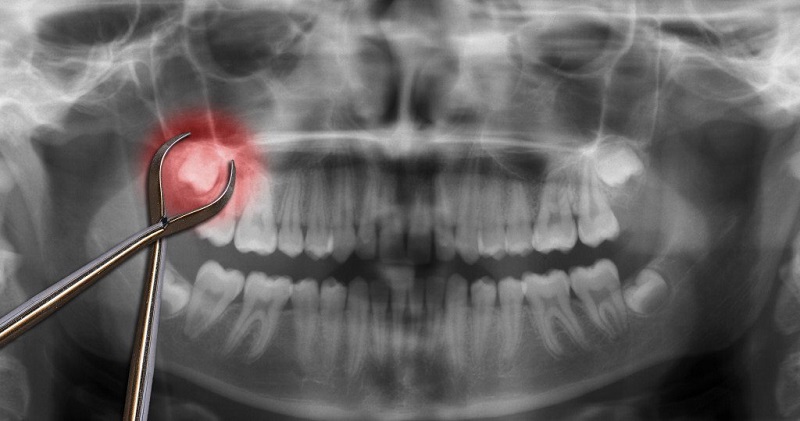In your mouth, you have what is famously called wisdom teeth. These are the third set of molars. Normally, these teeth begin to appear during a person’s teenage years or early adulthood. A wisdom tooth is supposed to fully emerge into the mouth. When that fails to happen, a number of complications may rear themselves. Some involve misalignment of at least some part of the jaw and teeth. Here, we will describe the causes, symptoms, and treatments of another problem with impacted wisdom teeth — a wisdom tooth infection.

What Is a Wisdom Teeth Infection?
An infection in or near the wisdom tooth goes by the more formal name of pericoronitis. As explained more fully below, it arises from bacteria that are able to invade an opening in the gums of your teeth. It gets the name wisdom tooth infection because of its location.
As you read below, wisdom tooth infection is most likely to happen because the wisdom tooth does not fully take its place in your mouth. As such, this infection can affect patients in their late teens to early 20s, during the time that the wisdom tooth would appear — at least partially, if not fully.
The typical effects of this type of infection include pain, difficulty in using your mouth, and inflammation of gums. However, it is possible that, when not given proper attention, an infection can lead to serious or even fatal outcomes.
The theory for the link between oral infections and more serious diseases arises from the fact that the bacteria can move from the wisdom tooth area into the bloodstream. The infection could find its way into organs such as your heart. The bacteria and its plaque could block arteries.
How Do Wisdom Teeth Get Infected?
The genesis of an infection in the wisdom tooth is the failure of the tooth to fully erupt. This means it could partially appear. The wisdom teeth may get lodged in the gums because your jaw doesn’t have enough room to fully erupt.
As a result of the impacting or partial appearance, a flap develops and provides a harbor for the infection. The flap provides a place to trap food, sugar, and other food particles. When these are not removed through brushing and flossing, the particles interact with bacteria to form a filming area of plaque.
Wisdom Teeth Infection Symptoms
You can feel the onset of an infection from pain in and around the wisdom tooth area. This also includes swollen or sore lymph nodes, which are located under your jaw. In addition to the pain, you may experience as symptoms of wisdom teeth infection the following:
- A red and inflamed gum near your wisdom tooth
- Pus emanating from the gum
- Bad breath, which may be the result of the plaque, bacteria, or food particles that are decaying
- Gum swelling
- Difficulty opening your mouth and swallowing
- Fever

Infected Wisdom Tooth Treatment
At a minimum, an infection in or around the wisdom tooth is treated with antibiotics to address the infection. These may include a prescription of amoxicillin or erythromycin. The prescription of chlorhexidine or a homemade remedy consisting of warm salt water or diluted hydrogen peroxide may also treat the symptoms of pericoronitis. Using ibuprofen or acetaminophen addresses the pain.
Beyond attacking the infection and treating the symptoms, pericoronitis ultimately doesn’t go away without getting at the heart of the problem. This is the condition that allows the bacteria to fester in the first place. To remove the flap that provides the breeding ground, your dentist or periodontist may do oral surgery to graft the overlap.
Ultimately, the wisdom tooth, if it is never going to fully erupt, has to be pulled or extracted. In the extraction procedure, you will be given anesthesia in the wisdom tooth area so that you will not feel any pain or discomfort of significance. The procedure normally lasts under half an hour, sometimes as little as 20 minutes.
Once the numbing wears off, you will experience a period of discomfort and swelling. Also, the aftermath of a wisdom tooth extraction may include a dry socket. A dull ache or unpleasant odor or taste may develop in the socket that once held the wisdom tooth. The dry socket phenomenon can be reduced, if not eliminated, by following your dentist’s post-operation instructions.
Wisdom Tooth Infection Prevention
In some cases, a wisdom tooth extraction is a pre-emptive strike against wisdom tooth infection. The dentist may recommend this upon seeing signs that a tooth will not fully erupt. The x-rays taken at regular dental visits or even by orthodontists reveal the potential problem. In fact, teenagers may experience fewer or not as burdensome complications from a tooth extraction. Unlike that of adults, the root of children’s and teenagers’ teeth have not fully developed.
Furthermore, as an oral infection is a creation of bacteria, you can take steps to reduce the risk that you will develop an infection of your wisdom tooth. These healthy practices include:
- Brushing your teeth twice a day, especially after the first and last meals of the day. You do not want food particles resting overnight in the flap of your gums or other spaces in your mouth.
- Likewise, floss at least once a day, especially in the evening before you retire for the day.
- Limit, if not avoid, sugary foods. Hard or sticky candy may prove more difficult to remove because it can become lodged in crevices of your mouth and teeth.
- Regularly visit your dentist. This means at least two visits a year for cleaning. The dentist will examine your teeth during the regular checkups. Depending upon the preference of your dentist, you may have an x-ray every other visit.
If the pain and irritation are not enough, the prospect of serious and potentially fatal diseases may spur you to seek prompt treatment of wisdom teeth infections. Please feel free to share your experiences with wisdom teeth infection, if you’ve ever had one, and what you used to alleviate its symptoms or to solve the problem once and for all.

Leave a Comment